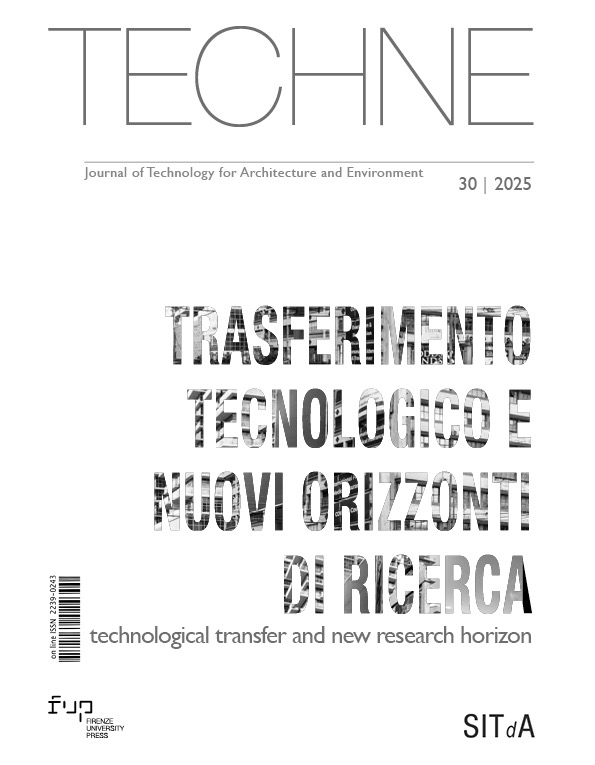Published 2025-11-07
Keywords
- urban digital twin,
- decision support system,
- positive energy district,
- climate-neutral cities,
- joint lab
How to Cite
Copyright (c) 2025 Paola Marrone, Paolo Civiero, Roberto D'Autilia, Valerio Palma

This work is licensed under a Creative Commons Attribution 4.0 International License.
Abstract
The article presents a study developed within the innovation ecosystem of Rome Technopole, focusing on technology transfer in the field of Key Enabling Technologies. The research addresses energy and digital transition in urban regeneration, aiming to create a tool for the co-production of knowledge to support planning for climate-neutral urban districts. The results validate the collected knowledge framework and the developed digital model through a case study applied to Rome’s Ostiense district, highlighting the methodology’s replicability, the scalability of the proposed tools, and their potential for future industrial applications and sustainable urban policymaking.
Downloads
References
- Agugiaro, G., Benner, J., Cipriano, P. and Nouvel, R. (2018), “The Energy Application Domain Extension for CityGML: Enhancing Interoperability for Urban Energy Simulations”, Open Geospatial Data, Software and Standards, Vol. 3, n. 2. Available at: https://doi.org/10.1186/s40965-018-0042-y (Accessed on 28/02/2025). DOI: https://doi.org/10.1186/s40965-018-0042-y
- Bibri, S.E., Huang, J., Jagatheesaperumal, S.K. and Krogstie, J. (2024), “The Synergistic Interplay of Artificial Intelligence and Digital Twin in Environmentally Planning Sustainable Smart Cities: A Comprehensive Systematic Review”, Environmental Science and Ecotechnology, Vol. 20, p. 100433. Available at: https://doi.org/10.1016/j.ese.2024.100433 (Accessed on 28/02/2025). DOI: https://doi.org/10.1016/j.ese.2024.100433
- Biljecki, F. (2017), Level of detail in 3D city models, TU Delft. Available at: https://doi.org/10.4233/uuid:f12931b7-5113-47ef-bfd4-688aae3be248 (Accessed on 28/02/2025).
- Bolton, A., Butler, L., Dabson, I., Enzer, M., Evans, M., Fenemore, T., Harradence, F., Keaney, E., Kemp, A., Luck, A. et al. (2018), Gemini Principles, CDBB. Available at: https://doi.org/10.17863/CAM.32260 (Accessed on 28/02/2025).
- Civiero, P., Pascual, J., Arcas Abella, J., Bilbao Figuero, A. and Salom, J. (2021), “PEDRERA. Positive Energy District Renovation Model for Large Scale Actions”, Energies, Vol. 14, n. 10, p. 2833. Available at: https://doi.org/10.3390/en14102833 (Accessed on 28/02/2025). DOI: https://doi.org/10.3390/en14102833
- Ferrando, M., Causone, F., Hong, T. and Chen, Y. (2024), “Urban Building Energy Modeling (UBEM) tools: A state-of-the-art review of bottom-up physics-based approaches”, Sustainable Cities and Society, Vol. 62, p. 102408. Available at: https://doi.org/10.1016/j.scs.2020.102408 (Accessed on 28/02/2025). DOI: https://doi.org/10.1016/j.scs.2020.102408
- Grieves, M. and Vickers, J. (2017), “Digital Twin: Mitigating Unpredictable, Undesirable Emergent Behavior in Complex Systems”, in Kahlen, F.-J., Flumerfelt, S. and Alves, A. (Eds.), Transdisciplinary Perspectives on Complex Systems, Springer, Cham, pp. 85-113. Available at: https://doi.org/10.1007/978-3-319-38756-7_4 (Accessed on 28/02/2025). DOI: https://doi.org/10.1007/978-3-319-38756-7_4
- Gröger, G., Kolbe, T.H., Nagel, C. and Häfele, K.H. (2012), OGC City Geography Markup Language (CityGML) Encoding Standard. Available at: https://www.ogc.org/publications/standard/citygml/ (Accessed on 28/02/2025).
- Kritzinger, W., Karner, M., Traar, G., Henjes, J. and Sihn, W. (2018), “Digital Twin in Manufacturing: A Categorical Literature Review and Classification”, IFAC-PapersOnLine, Vol. 51, n. 11, pp. 1016-22. Available at: https://doi.org/10.1016/j.ifacol.2018.08.474 (Accessed on 28/02/2025). DOI: https://doi.org/10.1016/j.ifacol.2018.08.474
- OpenAI (2023), “GPT-4 Technical Report”, arXiv preprint arXiv:2303.08774. Available at: https://doi.org/10.48550/arXiv.2303.08774 (Accessed on 28/02/2025).
- OpenStreetMap contributors (2025), Planet dump retrieved from https://planet.osm.org. Available at: https://www.openstreetmap.org (Accessed on 28/02/2025).
- Regione Lazio (2014). Database GeoTopografico (DBGT) – Scala 1:5.000 – v. 2014 – Formato SpatiaLite. Available at: https://geoportale.regione.lazio.it/documents/261 (Accessed on 28/02/2025).
- Yao, Z., Nagel, C., Kunde, F., Hudra, G., Willkomm, P., Donaubauer, A., Adolphi, T. and Kolbe, T.H. (2018), “3DCityDB – a 3D Geodatabase Solution for the Management, Analysis, and Visualization of Semantic 3D City Models Based on CityGML”, Open Geospatial Data, Software and Standards, Vol. 3, n. 5. Available at: https://doi.org/10.1186/s40965-018-0046-7 (Accessed on 28/02/2025). DOI: https://doi.org/10.1186/s40965-018-0046-7
- Wan, L., Nochta, T. and Schooling, J.M. (2019), “Developing a City-Level Digital Twin – Propositions and a Case Study”, in International Conference on Smart Infrastructure and Construction 2019 (ICSIC), ICE Publishing, Cambridge, UK, pp. 187-94. Available at: https://doi.org/10.1680/icsic.64669.187 (Accessed on 28/02/2025). DOI: https://doi.org/10.1680/icsic.64669.187






